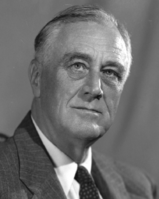1940_United_States_presidential_election_in_Tennessee
1940 United States presidential election in Tennessee
Election in Tennessee
The 1940 United States presidential election in Tennessee took place on November 5, 1940, as part of the 1940 United States presidential election. Tennessee voters chose 11[2] representatives, or electors, to the Electoral College, who voted for president and vice president.
For over a century after the Civil War, Tennessee was divided according to political loyalties established in that war. Unionist regions covering almost all of East Tennessee, Kentucky Pennyroyal-allied Macon County, and the five West Tennessee Highland Rim counties of Carroll, Henderson, McNairy, Hardin and Wayne[3] voted Republican – generally by landslide margins – as they saw the Democratic Party as the "war party" who had forced them into a war they did not wish to fight.[4] Contrariwise, the rest of Middle and West Tennessee who had supported and driven the state's secession was equally fiercely Democratic as it associated the Republicans with Reconstruction.[5] After the disfranchisement of the state's African-American population by a poll tax was largely complete in the 1890s,[6] the Democratic Party was certain of winning statewide elections if united,[7] although unlike the Deep South Republicans would almost always gain thirty to forty percent of the statewide vote from mountain and Highland Rim support.
In 1920 by moving into a small number of traditionally Democratic areas in Middle Tennessee[8] and expanding turnout due to the Nineteenth Amendment and powerful isolationist sentiment,[9] the Republican Party captured Tennessee's presidential electoral votes and won the governorship and three congressional seats in addition to the rock-ribbed GOP First and Second Districts. In 1922 and 1924, with the ebbing of isolationist sympathy and a consequent decline in turnout,[10] the Democratic Party regained Tennessee's governorship and presidential electoral votes; however, in 1928 anti-Catholicism against Democratic nominee Al Smith in this powerfully fundamentalist state[11] meant that Herbert Hoover bettered Harding’s performance without however gaining the down-ballot coattails of 1920.
These Republican gains would be completely reversed in the 1930s due to the impact of the Great Depression, which was generally blamed upon the Republican Party’s policies during the 1920s. Internal divisions prevented the Republicans taking advantage of a disputed Democratic gubernatorial primary in 1932 between Lewis Pope and Hill McAlister,[12] and for the next third of a century the Republicans would rarely contest statewide offices seriously despite their continuing dominance of East Tennessee and half a dozen Unionist counties in the middle and west of the state.[13] Statewide politics for the decade and a half after the beginning of the Depression would be dominated by Edward Hull “Boss” Crump, whose Memphis political machine would consistently provide decisive votes in statewide Democratic primaries — aided by cross-party voting by Republicans in eastern mountain counties.[13] Crump would be supported during this era by long-serving Senator Kenneth Douglas McKellar, and in 1938 when several statewide candidates allied themselves with Tennessee’s other Senator, Gordon Browning, the Crump/McKellar machine not merely defeated the collaboration, but even unseated Senator Browning.[14]
Incumbent President Franklin D. Roosevelt, who was now running with Secretary of Agriculture Henry A. Wallace in place of incumbent Vice President John Nance Garner, would visit Tennessee at the beginning of September.[15] In his visit he defended his accomplishment as Assistant Secretary of the Navy in the Wilson administration, and the work of the Tennessee Valley Authority which the New Deal had created. Republican nominee Wendell Willkie and running mate Minority Leader and Oregon senior Senator Charles L. McNary did not comment[16] or visit the state. A Gallup poll in mid-october showed Roosevelt maintaining his 1936 68 percent vote percentage,[17] and in the end Roosevelt carried Tennessee with 67.25 percent of the popular vote to 32.35 percent for Willkie.[18]


